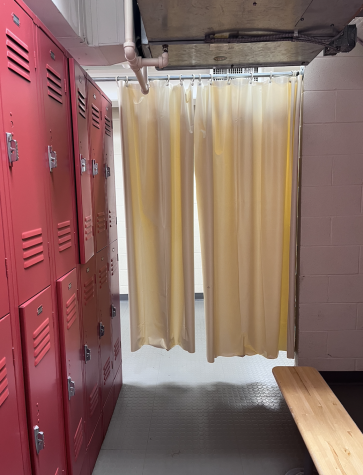Transphobia, Intolerance, and Obstinance: An In-Depth Look at Clark Athletics’ Treatment of Transgender Students
In March of the spring semester, the Clark Athletics Department announced to the student body via email that they had made changes in the Kneller Athletics Center to construct gender-inclusive changing spaces in both the men’s and women’s locker rooms.
Frankly, it is ridiculous – borderline insulting even – to install gender-neutral changing areas as a way of mitigating the problem of trans exclusion in Clark University Athletics. The Kneller Athletic Center’s swimming pool can only be accessed via the men’s or women’s locker room. To access the pool, trans students must fit themselves into the two pre-approved genders Clark Athletics has, and subsequently subject themselves to the cisnormative environment of a locker room; an environment that is built on making those who are gender non-conforming feel ostracized and unsafe.

The area meets the parameters of its somewhat vague description of a “curtained-off area [with] signage.” The privacy screen appeared to be two old shower curtains hung from the ceiling, neither of which were long enough to actually reach the floor, leaving about an eight-inch gap at the bottom. Because of the rubbery material the curtains were made out of, they also could not fully overlap, leaving an additional three to five-inch gap along the middle of the privacy screen. As if that was not enough, the changing room’s location is also directly in front of the door to the locker room, forcing anyone entering or leaving to pass by the space with its abundance of holes.
At the end of their email announcing this space to students and staff, the Athletics Department stated they are “committed to fostering an inclusive environment that’s empathetic, encouraging, and enjoyable for all individuals and groups.” When asked if they had any comment on the state of the changing area and the department’s commitment to trans advocacy, Associate Athletic Director Kirsten Clark stated, “We continue to work with ISEA and the Gender and Sexuality Task Force to look for avenues for our spaces to be more inclusive.”
The Clark Athletics Department, a majority cisgender and heterosexual environment, has faced scrutiny from students for years over their lack of inclusivity toward LGBTQ students, particularly trans and gender non-conforming students. This upgrade to the Kneller has been one of the most significant moves made by the Athletic Department to show an acknowledgment of trans students I have seen in my time at Clark, and it has somehow still managed to subvert my expectations.
As we are now a little over two months past the installation of this upgrade, I wanted to know how other students have been experiencing Clark’s athletic facilities, and if this upgrade had positively impacted their experience at all.
In an online poll asking Clark students about their likelihood to utilize the Kneller’s new upgrades, 37% stated the new changing area did not impact their likelihood of visiting, and 2% even stated it decreased their likelihood of visiting. 0% stated this change increased their desire to use the Kneller facility more.
This change to the Kneller Athletic Center did not meet a single parameter trans students have been asking for. The need for a gender-neutral changing area was requested because the environment fostered in locker rooms is one designed to subjugate people who do not conform to a cisgender heterosexual identity, specifically transgender people. All the Athletics Department has accomplished in their installation of this area is a way for cisgender people to identify transgender people in the Kneller locker room faster.
 Trans students have asked Clark Athletics time and time again for things that are, frankly, menial changes to their operations – things such as reserved time in the gym for female and trans students or safer locker rooms for trans athletes. So far neither of these requests have been met. While the Clark Athletics Department may say they are committed to acknowledging these requests, their policies tell a different story.
Trans students have asked Clark Athletics time and time again for things that are, frankly, menial changes to their operations – things such as reserved time in the gym for female and trans students or safer locker rooms for trans athletes. So far neither of these requests have been met. While the Clark Athletics Department may say they are committed to acknowledging these requests, their policies tell a different story.
On the Clark Athletics website under the “student-athletes” tab is a clickable page titled “transgender policy.” While it does feel somewhat demeaning for the page’s title to be “transgender policy” as though we are a cup of coffee that might not be permitted into the gym for cleanliness reasons, it did feel slightly uplifting to know there was – or at least what I thought was – set protections for trans student-athletes.
What I found instead was an official guidebook on the “handling” of transgender student-athletes as per the NCAA guidelines.
The language of both Clark’s policy and the NCAA’s states that a trans man may compete on either the men’s or women’s teams, but only the men’s team if they are transitioning using testosterone. Additionally, they, if transitioning hormonally, must receive a written exemption by the NCAA in order to compete using what they refer to as “banned drugs.”
While Clark Athletics and the NCAA may feel empowered to compare hormone treatment to anabolic steroid use, the two in reality are incredibly different. A study done by the Mayo Clinic found that 81% of cisgender male steroid users take 400mg of testosterone per week or more. Conversely, the University of California’s Gender Affirming Health Program states that, on average, the amount of testosterone prescribed to a transgender man is about 50mg per week. Nearly ten times less than the amount taken via steroids. Trans people, despite what the NCAA and apparently by extension Clark Athletics might think, are not taking testosterone to get a leg up; no doctor in their right mind would prescribe someone 400mg or more of testosterone per week.
Clark’s “transgender policy” continues to state that no trans women may compete on any women’s sports team until at least “one calendar year of testosterone suppressant treatment” has been completed; another medical barrier cisgender students do not ever need to consider in athletics.
These are the kinds of policies barring trans students from playing sports at Clark. Installing a gender-neutral changing area is moot, laughable even, when the doors of entry to athletics are barred by medical expenses most college students cannot afford on their own. Not to mention the blindness of assuming every transgender student coming through Clark will fit themselves into the boxes of male or female. Not every transgender person on earth wants to, is able to, or can afford to undergo a medical transition. Making such things a requirement means preventing many trans athletes from continuing sports throughout their college careers.
On the condition of anonymity, a former trans Clark student-athlete agreed to speak with me about their experience with Clark Athletics. “Some of the intense binary is a result of NCAA rules around competition that are outside of Clark Athletics control,” they said. In their time at Clark, they were a cross-country athlete and, between their sophomore and junior years, came out as transgender.
“However, especially with a sport like cross country, there are a lot of ways that gendered aspects could be decreased… at times I noticed what felt like an almost middle school antagonism toward the men’s team,” the former NCAA athlete stated. They left the cross-country team shortly after coming out as nonbinary.
While much of the transphobia in college athletics seems to be a symptom of the NCAA’s lack of trans inclusivity, that behavior often leaks over into coaches and staff, and Clark is no exception.
“The most intense transphobia and general bigotry I experienced in Clark Athletics were from the Athletic trainers – specifically the head [trainer], Greg White,” the alum stated.
“Throughout my time on the team, I had a chronic recurring injury that meant I had to go to him for treatment regularly. He made some comments that made me uncomfortable while I was in his presence, especially toward female athletes and visibly queer students. It honestly gave energy similar to a frat house in the athletic training room sometimes.”
In another online poll, when asked if they consider Clark Athletics to be transphobic, 78% of Clark students stated they do find the department transphobic, while 22% said they do not.
When further questioned, 100% of polled students stated they do not believe Clark Athletics is trans-inclusive.
Where do we draw the line, then, between a “lack of inclusivity” versus transphobia? If Clark Athletics, a department that many students do not consider to be trans-inclusive, makes no move to be more trans-inclusive, is that transphobia? As they are now, the system and policies upheld by Clark Athletics are actively preventing transgender students from participating in sports both recreationally, personally, and at the varsity level.
When we participate in NCAA-regulated sports we are met with expensive and required medical expenses. The birth control pill was literally invented at Clark University in 1960; how are we still running into problems with bodily autonomy? For many trans people medical transitions are not possible for health reasons, financial reasons, or simply personal preference. It is not reasonable to expect trans people to assimilate to a cis-normative gender binary in order to participate in sports, especially when medical treatment would be required to do so. It is unethical to force us to undergo medical treatment to play sports alongside everyone else.
When we participate in recreational athletics, trans students are met with Athletic Department staff who continue outdated locker room behavior. Simply being in the room as misogynistic conversations take place is enough to make that room an unsafe place for trans students.
Clark Athletics may say they work hard to uphold their commitment to inclusive athletics, but they work harder to uphold policies written with the intention of keeping trans people out of sports.

